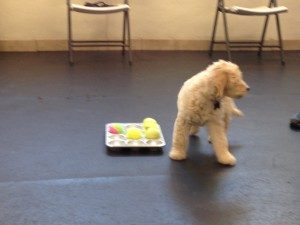We’re delighted you’re here! Our goal for this course is to help you build a great relationship with your puppy while you both learn how to communicate with one another more effectively.
Puppy Kindergarten is designed for puppies and their people to join the class whenever the pup has completed his or her first round of shots. This is so that socialization to the big exciting world can begin during formative periods. We want puppies to have good experiences with all the new things they encounter in their young lives.
Each week the class will include:
- Information on a topic about training, and/or puppy behavior and development
- A confidence-building socialization exercise
- Behavior(s): training one skill with variations, or two different skills
- Relaxation / Attention
- Play
How we Train.
We reward what we like.
We ignore what we don’t like.
Unless it’s an urgent matter of safety we ignore behavior that we don’t like. Learning theory tells us that behavior which is rewarded (reinforced) will become more frequent, while behavior which is not rewarded will become less frequent. Oftentimes simply saying “no” in response to a behavior that we don’t like is so reinforcing for our dog that the undesirable behavior becomes more frequent—just exactly what we don’t want. If a behavior is becoming stronger or more frequent, be a detective and figure out what is reinforcing the behavior.
We click!
We use clickers to mark the behaviors we like, and follow the click with a tiny food reward. Our puppies come to quickly love the sound of the click because it predicts a yummy treat. They learn to work to earn clicks and treats. We also teach our pups a verbal marker because there will be times that we want to mark a behavior, but don’t have a clicker, or don’t have a spare hand to make a click!
A bit of training geek info: Brain studies show that the sound a clicker makes affects the brain at a more primitive level than a verbal marker will. As a result the training effect of a clicker is more powerful. A verbal marker is great, but if you can use a clicker your training will be faster.
We are generous and stingy.
We are generous with the number of click/treats, using a high rate of reinforcement to train a new behavior or strengthen an older one that needs brushing up. We are stingy with the size of our food treats, though! A treat the size of a small pea is plenty. It is the frequency of reward that moves training forward.
We practice success.
We set the difficulty of whatever we are training at a level where our dogs will succeed, rather than setting the difficulty too high so that they fail. In a training model which involves setting the dog up to fail (or “misbehave”) so that they can be “corrected” (punished) the dogs may learn specific behaviors to fluency, but they become less willing to try new behaviors, and the relationship of trust between dog and human can be damaged or broken. We want to help our pups to practice a successful behavior on which we can build, gradually raising the bar, and creating a great relationship at the same time.
Things to Bring
- Your Pup!
- Well-behaved children and spouses 8 or older.
- A flat collar, harness, or martingale collar.
- Lots of pea-sized soft treats in at least two different flavors. 200 tiny pieces are not too many. Some suggestions: Hot dogs, String cheese, Meatballs, Chicken or Tuna, Baby food (in a camping tube), Vienna sausages, Liverwurst, Thin-sliced Beef.
- A fanny pack, carpenter’s apron, or treat pouch to hold your 200 tiny pieces.
- A 6-foot leash.
- A mat, bathmat, towel, or blanket for your puppy or dog to rest on.
- Water and a bowl for when your pup gets thirsty.
Do's and Don'ts
- Do let us know if your pup has any food allergies so that we can be careful not to give him a troublesome treat.
- Don’t bring prong, choke, shock, or citronella collars.
- Don’t bring Flexi or other retractable leashes.
- Puppies and dogs should not meet while on leash in class, or while coming and going. There will be opportunities for off-leash play for compatible puppies, and good neighbor exercises for older pups and dogs.
- Don’t feed a heavy meal before coming to class. In fact, your in-class treats can serve as your dog’s breakfast on class day!
- If your puppy or dog is ill, please leave him at home to recuperate, but feel free to come to class without him so that you can learn what’s on the agenda for that day.
Puppy Kindergarten
Puppy Topics
Puppy eBooks
- Ian Dunbar’s Before You Get Your Puppy
- Ian Dunbar’s After You Get Your Puppy
Training Video
Homework 1
- Play with your puppy.
- Catch your pup in the act of doing five different things you like. Click and Treat. Repeat.
Homework 2
- Have your dog “Wait” for you to put her food bowl down for each meal.
- Couple handling with treats a few times a day.
Homework 3
- Practice Loose Leash Walking in a new location. Remember that three good steps are so much better than thirty steps on a tight leash.
- Look for features on your walks that can serve as parts of an Out-and-About Confidence Course.
Homework 4
- Surprise your dog with ten treats in ten seconds at least three times a day.
- Practice the Name Game three times a day.
Homework 5
- Discover a new opportunity to help your dog choose an appropriate behavior.
- Write down the first five steps that you would train.


